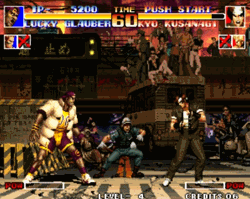 If you want to understand the essence of a videogame crossover, you need look no further than King of Fighters ’94.
If you want to understand the essence of a videogame crossover, you need look no further than King of Fighters ’94.
King of Fighters was initially imagined as a beat ‘em up titled Survivor. The prototype featured characters from The Art of Fighting and Fatal Fury (two established SNK fighting games) battling in teams of three against waves of vaguely anonymous mooks. Given both of the parent games were about burly dudes fighting against criminal gangs, this seemed like a natural progression in both storylines and gameplay. But, presumably because fighting games were really hitting their stride around the early 90s, Survivor the beat ‘em up mutated into King of Fighters the fighting game. The concept of three-man teams survived the transition, and, more importantly, King of Fighters maintained its status as a crossover title involving two popular SNK franchises.
And then things got weird. Two more games were included in the crossover hijinks: Psycho Soldier Starring Athena and Ikari Warriors. And if you’re curious what those games look like…
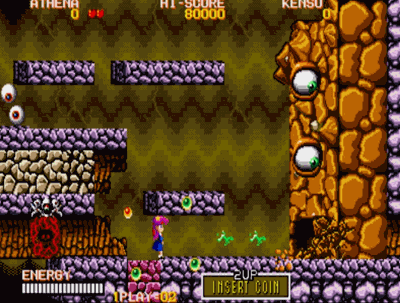
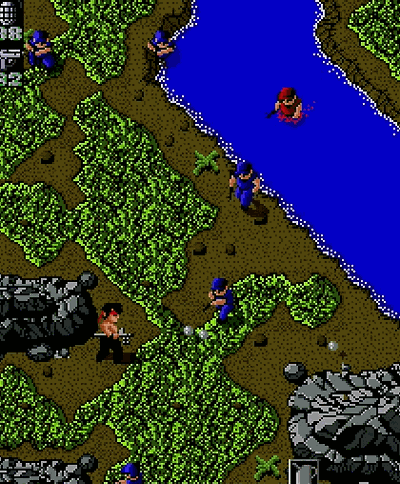
So what happens when you try to marry that to something like this?
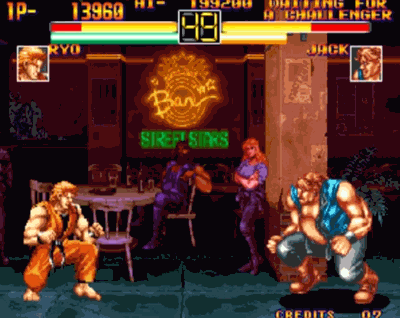
Well, in the end, you wind up with this:
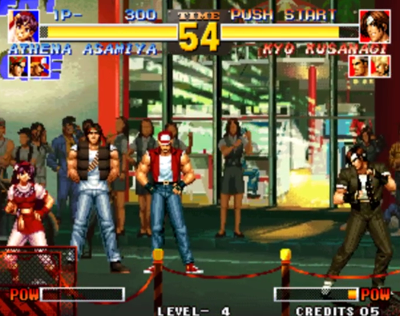
But it might take a moment to get there.
To understand what happened, you have to understand the insane leaps and bounds that happened in gaming in the 80s and 90s. Remember Pac-Man? His debut was released in 1980. Pac-Man could be controlled with zero buttons, one four-way paddle, and a human being that didn’t need to understand anything more than “Pac-Man go wakka wakka”. Pac-Man had no “moves” other than simply moving, and his opponents were four of the same guy in different colored coats. Pac-Man did not jump, duck, dash, or even attack in any way that didn’t just involve steering around a maze. And even when Ms. Pac-Man or Super Pac-Man made the scene, it was still the same basic gameplay that was little more than tracing your finger around a children’s menu placemat. But, from there, we graduated to games where there was shooting, jumping, and the occasional bit of shooting and jumping. Games that started with “Mario go hop” evolved into finding ways that one could attack or otherwise interact with the world through that jumping, and, by as early as the late-80’s, we already needed tutorials and alike to explain exactly what happens when you use a grenade over your basic rifle.
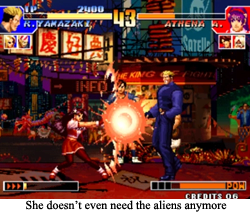 So Ikari Warriors, essentially a top-down copy of Contra (… which gets no credit from this blog for being released a year before Contra), was released in the early days of games becoming “complicated”. There were two buttons! You could control a man and a tank! Two players could simultaneously coordinate their attacks and work together! Or compete for powerups! Ikari Warriors was much more complicated than Pac-Man or Space Invaders, but it still wasn’t that complicated. Run ‘n gun is the basic gist of it, and you really don’t need an intricate control scheme to dodge bullets. And, while the setting is very different, Psycho Soldier, released the same year, is a very similar situation. This game is 2-D, and it features school children with psychic powers, but it still boils down to “dodge attacks, shoot bad guys”. In this case, the “complicated bits” involve debating on whether or not to conduct some light demolition when the auto-scroll is bearing down on your idol, and considering the merits of grabbing a powerup that may or may not be erased about seven seconds later by an errant giant beetle. It’s… a weird game. Regardless, in both Ikari Warriors and Psycho Soldier, we’ve got gameplay significantly more complicated than “pizza man stuck in a maze”.
So Ikari Warriors, essentially a top-down copy of Contra (… which gets no credit from this blog for being released a year before Contra), was released in the early days of games becoming “complicated”. There were two buttons! You could control a man and a tank! Two players could simultaneously coordinate their attacks and work together! Or compete for powerups! Ikari Warriors was much more complicated than Pac-Man or Space Invaders, but it still wasn’t that complicated. Run ‘n gun is the basic gist of it, and you really don’t need an intricate control scheme to dodge bullets. And, while the setting is very different, Psycho Soldier, released the same year, is a very similar situation. This game is 2-D, and it features school children with psychic powers, but it still boils down to “dodge attacks, shoot bad guys”. In this case, the “complicated bits” involve debating on whether or not to conduct some light demolition when the auto-scroll is bearing down on your idol, and considering the merits of grabbing a powerup that may or may not be erased about seven seconds later by an errant giant beetle. It’s… a weird game. Regardless, in both Ikari Warriors and Psycho Soldier, we’ve got gameplay significantly more complicated than “pizza man stuck in a maze”.
But it ain’t no fighting game.
It is the belief of Gogglebob.com and its subsidiaries that fighting games require the most complicated “controls” of any genre. There are games that, on a whole, are more complicated (looking straight at you, TRPGs), but usually those “complicated” games require a meager “point and click” or “press A on the right menu” interface. Meanwhile, fighting games often have more required action buttons than your average console controller, intricate motions for “specials”, and even more elaborate patterns for those all-important super/hyper/tension moves. This isn’t to say that there aren’t fighting games that eschew those convoluted controls, but most fighting games still trace back to a certain title that included six different fighting buttons that may or may not have produced different results if you were standing or moving.
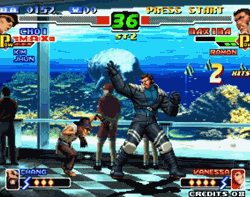 Or, put another way, in 1991, there was a new videogame where a hedgehog could run, jump, crouch, and roll. Also in 1991, there was a new game where a karate champion could walk, block, crouch, defensive crouch, back flip, forward flip, jump, jab, strong punch, fierce punch, short kick, forward kick, roundhouse, jump jab, jump strong punch, jump fierce punch, jump short kick, jump forward kick, jump roundhouse, crouch jab, crouch strong punch, crouch fierce punch, crouch short kick, crouch forward kick, crouch roundhouse, throw a fireball, hurricane kick, and dragon punch. Same year, two very fondly remembered games, but just a smidge of difference between what their two protagonists can do.
Or, put another way, in 1991, there was a new videogame where a hedgehog could run, jump, crouch, and roll. Also in 1991, there was a new game where a karate champion could walk, block, crouch, defensive crouch, back flip, forward flip, jump, jab, strong punch, fierce punch, short kick, forward kick, roundhouse, jump jab, jump strong punch, jump fierce punch, jump short kick, jump forward kick, jump roundhouse, crouch jab, crouch strong punch, crouch fierce punch, crouch short kick, crouch forward kick, crouch roundhouse, throw a fireball, hurricane kick, and dragon punch. Same year, two very fondly remembered games, but just a smidge of difference between what their two protagonists can do.
So, yes, there’s a little bit of a difference between Psycho Soldier Athena and King of Fighters ’94 Athena.
Athena and Sie Kensou both originated from a side-scrolling action game. Ralf Jones and Clark Still (names changed in America to protect the innocent) originated in a top-down action game (and Heidern, their third teammate, too, but he was mostly just a talking head). The ’94 American Sports Team of Lucky Glauber the basketball player, Brian Battler the football player, and Heavy-D! the boxer were meant to be evocative of their respective sports videogames of the era. How does Madden NFL ’94 gameplay translate to King of Fighters ’94? That’s Brian Battler’s beat! All of these characters from wildly disparate backgrounds and games were smooshed together, granted multiple attacks, special moves, and the occasional power move, and were able to fight on an even keel. King of Fighters ’94 found a way for Psycho Soldier Athena to stand shoulder to shoulder and fist to fist with Terry Bogard.
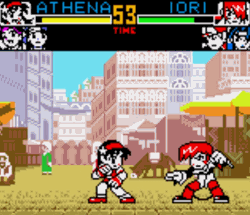 And what’s important here is that what made these “transplant” characters themselves in the first place is still there. Athena has the ability to toss off magical, psycho power moves. Ralf is towing heavy artillery and fighting in front of his crashed transport. Lucky Glauber can dunk on his opponents in more ways than one. They all have their punches, kicks, and uppercuts like Joe Higashi or Ryo Sakazaki, but they also retain moves and abilities that distinctly evoke their initial appearances. The arena is different, but these fighters with incongruent pasts are still recognizable as evolutions of their original forms. Clark is still Clark.
And what’s important here is that what made these “transplant” characters themselves in the first place is still there. Athena has the ability to toss off magical, psycho power moves. Ralf is towing heavy artillery and fighting in front of his crashed transport. Lucky Glauber can dunk on his opponents in more ways than one. They all have their punches, kicks, and uppercuts like Joe Higashi or Ryo Sakazaki, but they also retain moves and abilities that distinctly evoke their initial appearances. The arena is different, but these fighters with incongruent pasts are still recognizable as evolutions of their original forms. Clark is still Clark.
And, while later King of Fighters titles would not revisit the idea of pulling characters from other genres for some time (the first it returned was in ’99 with Metal Slug’s Fio as a mere striker [assist] character, and then we barely saw it in any other way save for spin-offs or the absolute most recent edition), it set the standard for what videogame crossovers would have to be. A crossover in a movie, novel, or television program doesn’t require completely redesigning the guest star du jour. The Golden Girls can guest star on Teen Titans Go and it doesn’t mean Darkseid can’t appear in the same episode (it happened! Look it up!), but if the cast of Empty Nest (more things to look up!) wants to appear in Super Mario Bros, they better learn to jump over turtles. The Avengers can be the most robust crossover film in history, but that’s because it’s only a movie drawing from other movies. They didn’t have to adapt a single action hero to a fighting game at all, and that makes the whole experience so much easier. Can you imagine trying to figure out a moveset for Wong? And then balancing that against a Wakandian warrior? The mind boggles!
So thank you, King of Fighters, for showing us all what a videogame crossover must be. It’s not about dropping as many ingredients as possible into the broth like in any other medium, it’s about adapting every participant from their contrasting origins to the featured genre. It’s about making a balanced, enjoyable experience that incidentally includes stars from times in gaming that have long been forgotten. It’s about going from this…
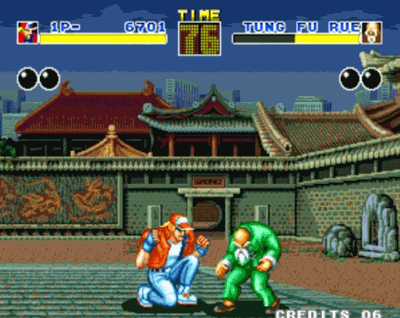
To this…
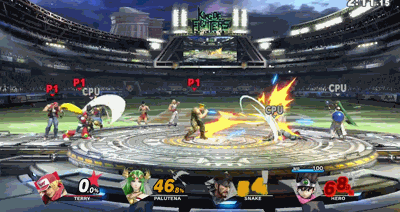
So thank you, King of Fighters, for defining the videogame crossover for generations.
FGC #492 King of Fighters (Franchise)
- System: Started out on the Neo Geo, but eventually migrated to various Playstation models. I’m sure the older versions are available on the Switch, too. So let’s just generically say it’s available wherever videogames are sold.
- Number of players: Two. It’s a fighting game. It’s two.
- Wait, wasn’t this article mostly about King of Fighters ’94, and not the whole franchise: Look, I’m not going to review each individual KoF game at this point, and ’95 is mostly the same as ’94 but with some much preferred upgrades, and some of the intervening games… Ugh, it’s already getting complicated. This article is my dedication to the franchise. I don’t want to get into explaining NESTS or why there’s now a idol sporting electric, fake eyeballs, and…. Stop it! This is just about King of Fighters and its impact on gaming at large. The end!
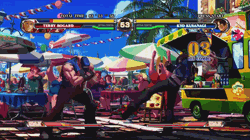 You really want to talk about the plot, don’t you? My main problem with the King of Fighters franchise is that, like some other games, what started as a simple crossover story rapidly added a host of original characters with singular motivations that made the entire experience completely impregnable to a player that just happened to be wandering through with a spare quarter or two. Kyo was an interesting addition to the cast that was deliberately built to appeal to the “new generation” (as Terry and Ryo were old men in their 20s by the time of KoF), but there was no way that entire plots needed to hang on his magical blood, fire-boy rivalry, or that time he got cloned for no apparent reason. Even when Kyo isn’t the literal center of the universe, you know you’re just five seconds away from his second cousin’s roommate appearing and declaring the start of “The Iron Blood Saga” or some such thing, and… can we just get a game where Samurai Shodown protagonists fight pachinko heroines?
You really want to talk about the plot, don’t you? My main problem with the King of Fighters franchise is that, like some other games, what started as a simple crossover story rapidly added a host of original characters with singular motivations that made the entire experience completely impregnable to a player that just happened to be wandering through with a spare quarter or two. Kyo was an interesting addition to the cast that was deliberately built to appeal to the “new generation” (as Terry and Ryo were old men in their 20s by the time of KoF), but there was no way that entire plots needed to hang on his magical blood, fire-boy rivalry, or that time he got cloned for no apparent reason. Even when Kyo isn’t the literal center of the universe, you know you’re just five seconds away from his second cousin’s roommate appearing and declaring the start of “The Iron Blood Saga” or some such thing, and… can we just get a game where Samurai Shodown protagonists fight pachinko heroines?- So do you have an explanation for this timeline where characters established as being from the 70s battle the large, adult sons of other combatants? Nope! Moving on.
- Favorite Character(s): Chang Koehan the giant and Choi Bounge the wee gremlin sporting a spiky hand are my favorite picks across the franchise. They’ve had a few other teammates over the years, so I can’t just say “Korean Team” or “Villains Team”. It’s those two. They’re awesome. They brought a wrecking ball to a fighting game. And apparently they were both originally conceived to add some levity to the initially dour cast of King of Fighters, so, ya know, mission accomplished.
- Favorite King of Fighters game: In this case, the most recent one is the best one, and that appears to be King of Fighters 14. After 13 was an unimpressive dud, 14 came roaring back with amazing graphics, an excellent “feel”, and more fanservice than I could shake a buster wolf at. My understanding is that this KoF is the start of a new storyline for the franchise, and I eagerly await whatever may be next.
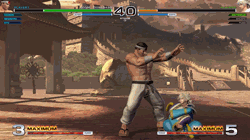 Goggle Bob Fact: I generally avoided this franchise in my childhood thanks to a Fighting Game Player’s Guide I picked up for Mortal Kombat information that incidentally covered the most recent King of Fighters game, too. The inputs for the KoF fighters looked so insane I didn’t even try the franchise for years for fear of having to properly activate Terry’s overly complicated burning knuckle or whatever. Fatal Fury 3, unfortunately, fell into the same boat. However, I eventually found King of Fighters ’95 on the Playstation (1) for a steal, and then I fell in love with a purple ninja and a boy with a stick. … Not literally. Mostly.
Goggle Bob Fact: I generally avoided this franchise in my childhood thanks to a Fighting Game Player’s Guide I picked up for Mortal Kombat information that incidentally covered the most recent King of Fighters game, too. The inputs for the KoF fighters looked so insane I didn’t even try the franchise for years for fear of having to properly activate Terry’s overly complicated burning knuckle or whatever. Fatal Fury 3, unfortunately, fell into the same boat. However, I eventually found King of Fighters ’95 on the Playstation (1) for a steal, and then I fell in love with a purple ninja and a boy with a stick. … Not literally. Mostly.- Did you know? The only team that did not return between King of Fighters ’94 and ’95 is the American Sports Team. Likely as a reference to this, multiple later games feature members of the team receiving invitations, but then being beaten and losing said invitations to other, newer (and usually more interesting) teams. But they seem to keep reappearing for cameos in other King of Fighter games (and even their spinoffs), so at least they’re still getting work.
- Would I play again: King of Fighters isn’t my favorite fighting game franchise (or even my favorite crossover fighting game franchise), but it’s still a fun time, so I’ll give some of these titles another go in the near future. Who doesn’t like psycho soldiers fighting regular soldiers?
What’s next? Crossover “Week” (I have really got to figure out a good title for “six articles with one basic premise” situations) continues with a look at a different kind of crossover to hit the arcades. It might not be a Vs. game, but it’s certainly got “Vs” in the title. Please look forward to it!
[…] are, as, if there’s a dedicated “special” button, I kind of assume it’s more simple than King of Fighters. Regardless, despite some gorgeous visuals, this game feels more like a budget release than […]
[…] final fighting boss appears as we discuss the possibility of a very bouncy King of Fighters […]
[…] the franchise that had to stick nylons on some scantily clad weapon ladies, and could not include King of Fighter’s Mai as a background character because her design was not built for good little boys and girls. […]